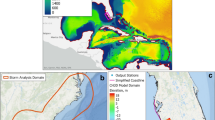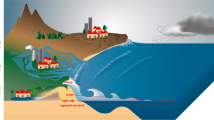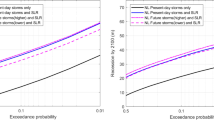Abstract
Climate-change (CC)-driven sea-level rise (SLR) will result in coastline retreat due to landward movement of the coastal profile (that is, the Bruun effect). Coastline change adjacent to commonly found tidal inlets will be influenced not only by the Bruun effect, but also by SLR-driven basin infilling and CC-driven variations in rainfall/runoff. However, as a model that accounts for all of the above-mentioned processes has been lacking so far, most coastal CC impact studies until now have considered only the Bruun effect. Here, we present a scale-aggregated model capable of providing rapid assessments of coastline change adjacent to small inlet-estuary/lagoon systems due to the combined effect of CC-driven SLR and variations in rainfall/runoff. Model applications to four representative systems show that the Bruun effect represents only 25–50% of total potential coastline change, and underline the significance of coastline change due to SLR-driven basin infilling and CC-driven variations in rainfall/runoff.
This is a preview of subscription content, access via your institution
Access options
Subscribe to this journal
Receive 12 print issues and online access
$209.00 per year
only $17.42 per issue
Buy this article
- Purchase on Springer Link
- Instant access to full article PDF
Prices may be subject to local taxes which are calculated during checkout


Similar content being viewed by others
References
Aubrey, D. G. & Weishar, L. Hydrodynamics and Sediment Dynamics of Tidal Inlets (Springer, 1988).
Carter, R. W. G. & Woodroffe, C. D. Coastal Evolution: Late Quaternary Shoreline Morphodynamics (Cambridge Univ. Press, 1994).
Woodroffe, C. D. Coasts: Form, Process and Evolution (Cambridge Univ. Press, 2002).
Davis, R. Jr & Fitzerald, D. M. Beaches and Coasts (Wiley, 2009).
Ward, L. G. & Ashley, G. M. Physical Processes and Sedimentology of Siliciclastic-dominated Lagoonal Systems (Elsevier, 1989).
Kjerfve, B. in Coastal Lagoon Process (ed. Kjerfve, B.) 1–7 (Elsevier, 1994).
Nicholls, R. J. et al. in IPCC Climate Change 2007: Impacts, Adaptation and Vulnerability (eds Parry, M. L. et al.) 315–317 (Cambridge Univ. Press, 2007).
Ranasinghe, R. & Stive, M. J. F. Rising seas and retreating coastlines. Climatic Change 97, 465–468 (2009).
Stive, M. J. F., Ranasinghe, R. & Cowell, P. in Handbook of Coastal and Ocean Engineering (ed. Kim, Y.) 1023–1038 (World Scientific, 2010).
Houghton, K. J, Vafeidis, A. T., Neumann, B. & Proelss, A. Maritime boundaries in a rising sea. Nature Geosci. 3, 813–186 (2010).
Gratiot, N. et al. Significant contribution of the 18.6 year tidal cycle to regional coastal changes. Nature Geosci. 1, 169–172 (2008).
Stive, M. J. F., Capobianco, M., Wang, Z. B., Ruol, P. & Buijsman, M. C. Proc. 8th Int. Biennial Conf. on Physics of Estuaries and Coastal Seas, The Hague 397–407 (A. A. Balkema, 1998).
Van Goor, M. A., Stive, M. J. F., Wang, Z. B. & Zitman, T. J. Impact of sea level rise on the morphological stability of tidal inlets. Marine Geol. 202, 211–227 (2003).
Hinkel, J. DIVA: An iterative method for building modular integrated models. Adv. Geosci. 4, 45–50 (2005).
Hinkel, J. & Klein, R. J. T. The DINAS-COAST project: Developing a tool for the dynamic and interactive assessment of coastal vulnerability. Glob. Environ. Change 19, 384–395 (2009).
Vafeidis, A. T. et al. A new global coastal database for impact and vulnerability analysis to sea-level rise. J. Coast. Res. 24, 917–924 (2008).
Dean, R.G. & Maurmeyer, E.M. in Handbook of Coastal Processes and Erosion Boca Raton (ed. Komar, P. D.) 151–166 (CRC, 1983).
FitzGerald, D. M., Fenster, M. S., Argow, B. A. & Buynevich, I. V. Coastal impacts due to sea-level rise. Annu. Rev. Earth Planet. Sci. 36, 601–647 (2008).
Walton, T. L. & Adams, W. D. Proc. 15th Coastal Engineering Conf., Honolulu 1919–1937 (ASCE, 1976).
Davies, J. L. Geographical Variation in Coastal Development (Longman, 1980).
Davis, R. A. & Hayes, M. O. What is a wave dominated coast. Marine Geol. 60, 313–329 (1984).
Ranasinghe, R., Pattiaratchi, C. & Masselink, G. A morphodynamic model to simulate the seasonal closure of tidal inlets. Coast. Eng. 37, 1–36 (1999).
Bruun, P. Sea-level rise as a cause of shore erosion. J. Waterways Harbors Div. 88, 117–130 (1962).
Zhang, K., Douglas, B. & Leatherman, S. Global warming and coastal erosion. Climatic Change 64, 41–58 (2004).
Stive, M. J. F. & Wang, Z. B. in Advances in Coastal Modelling (ed. Lakhan, C.) 367–392 (Elsevier, 2003).
O’Brien, M. P. Estuary and tidal prisms related to entrance areas. Civil Eng. 1, 738–739 (1931).
Van der Wegen, M., Dastgheib, A. & Roelvink, J. Morphodynamic modelling of tidal channel evolution in comparison to empirical PA relationship. Coast. Eng. 57, 827–837 (2010).
Wischmeier, W. & Smith, D. Agricultural Handbook No. 537 (US Government Printing Office, 1978).
Alley, R. B. et al. in Climate Change 2007: The Physical Science Basis (eds Solomon, S. et al.) 1–18 (Cambridge Univ. Press, 2007).
Schoof, C. Ice-sheet acceleration driven by melt supply variability. Nature 468, 803–806 (2010).
Solomon, S. et al. in IPCC Climate Change 2007: The Physical Science Basis (eds Solomon, S. et al.) 19–92 (Cambridge Univ. Press, 2007).
IPCC Climate Change 2007: Synthesis Report (eds Pachauri, R. K. and Reisinger, A.) (IPCC, 2007).
Acknowledgements
Z. B. Wang (Deltares/Delft University of Technology) is gratefully acknowledged for providing invaluable advice and guidance on the SLR-driven basin infilling process and the ASMITA model. R.R. would like to thank J. Bosboom (Delft University of Technology) and Ad van der Spek (Deltares) for early discussions pertaining to this research. This study was partly supported by the Deltares Coastal Maintenance Research Programme Beheer and Onderhoud Kust.
Author information
Authors and Affiliations
Contributions
R.R. and M.S. conceived the idea of the new model. R.R. developed and tested the model and wrote the manuscript. T.M.D. collated model input data and applied the model to field sites. S.U. provided all hydrological analysis for this study. D.R. provided strategic advice on coastal processes. All authors provided suggestions and comments on the manuscript.
Corresponding author
Ethics declarations
Competing interests
The authors declare no competing financial interests.
Supplementary information
Supplementary Information
Supplementary Information (PDF 392 kb)
Rights and permissions
About this article
Cite this article
Ranasinghe, R., Duong, T., Uhlenbrook, S. et al. Climate-change impact assessment for inlet-interrupted coastlines. Nature Clim Change 3, 83–87 (2013). https://doi.org/10.1038/nclimate1664
Received:
Accepted:
Published:
Issue Date:
DOI: https://doi.org/10.1038/nclimate1664
This article is cited by
-
Anthropogenic interventions on land neutrality in a critically vulnerable estuarine island ecosystem: a case of Munro Island (India)
Scientific Reports (2023)
-
Influence of El Niño on the variability of global shoreline position
Nature Communications (2023)
-
Failure analysis and mitigation of Shankumugham beach road, Kerala, India—a case study
Arabian Journal of Geosciences (2022)
-
Twenty-first-century projections of shoreline change along inlet-interrupted coastlines
Scientific Reports (2021)
-
Probabilistic projections of the stability of small tidal inlets at century time scale using a reduced complexity approach
Scientific Reports (2021)



